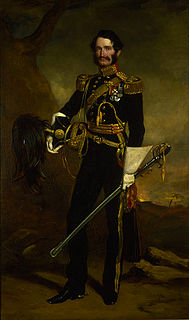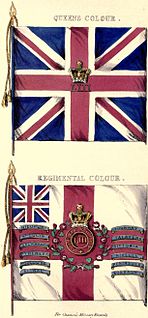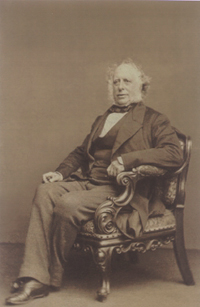
The First Anglo-Sikh War was fought between the Sikh Empire and the East India Company in 1845 and 1846. It resulted in partial subjugation of the Sikh kingdom and cession of Jammu and Kashmir as a separate princely state under British suzerainty.

The Second Anglo-Sikh War(First War of Sikh Independence) was a military conflict between the Sikh Empire and the British East India Company that took place in 1848 and 1849. It resulted in the fall of the Sikh Empire, and the annexation of the Punjab and what subsequently became the North-West Frontier Province, by the East India Company.

Major General Sir Henry Tombs VC KCB was a recipient of the Victoria Cross, the highest and most prestigious award for gallantry in the face of the enemy that can be awarded to British and Commonwealth forces.

General Sir James Hope Grant, GCB, was a British Army officer. He served in the First Opium War, First Anglo-Sikh War, Indian Mutiny of 1857, and Second Opium War.

Field Marshal Sir Patrick Grant, was a senior Indian Army officer. He fought at the Battle of Maharajpore during the Gwalior Campaign, at the Battle of Mudki, the Battle of Ferozeshah and the Battle of Sobraon during the First Anglo-Sikh War and at the Battle of Chillianwala and the Battle of Gujrat during the Second Anglo-Sikh War. During the Indian Mutiny, as acting Commander-in-Chief, India, he directed the operations against the mutineers, sending forces under Henry Havelock and James Outram for the relief of Cawnpore and Lucknow. He later became Governor of Malta.

Major-General Sir Robert Henry Sale GCB was a British Army officer who commanded the garrison of Jalalabad during the First Afghan War and was killed in action during the First Anglo-Sikh War.

The President's Bodyguard (PBG) is an elite household cavalry regiment of the Indian Army. It is senior-most in the order of precedence of the units of the Indian Army. The primary role of the President's Bodyguard is to escort and protect the President of India which is why the regiment is based in the Rashtrapati Bhavan in New Delhi, India. It is equipped as a mounted unit, with horses for ceremonies at the presidential palace and BTR-80 vehicles for use in combat. The personnel of the regiment are also trained as paratroopers and nominally are expected to lead in airborne assaults in the role of pathfinders. The regiment is the successor of the Governor General's Bodyguard of the British Raj.

The 53rd (Shropshire) Regiment of Foot was a British Army regiment, raised in 1755. Under the Childers Reforms it amalgamated with the 85th Regiment of Foot to form the King's Shropshire Light Infantry in 1881.
The 101st Regiment of Foot was an infantry regiment of the Honourable East India Company and British Army that existed from 1652 to 1881. The regiment was raised in India in 1652 by the East India Company as the Company's first non-native infantry regiment. Over the following two centuries, the regiment was involved in nearly all of the East India Company's conflicts which consolidated British rule over India. The Royal Bengal Fusiliers was transferred to the command of the British Army in 1862 following the Indian Mutiny of 1857 and the end of Company rule in India. Under the Childers Reforms it amalgamated with the 104th Regiment of Foot to form the Royal Munster Fusiliers in 1881.
The 7th Hariana Lancers was a cavalry regiment in the British Indian Army. It was formed in 1846 and in 1921 was amalgamated with the 6th King Edward's Own Cavalry to form the 18th King Edward's Own Cavalry.

The Bengal Army was the army of the Bengal Presidency, one of the three presidencies of British India within the British Empire.

The regiments of Bengal Native Infantry, alongside the regiments of Bengal European Infantry, were the regular infantry components of the East India Company's Bengal Army from the raising of the first Native battalion in 1757 to the passing into law of the Government of India Act 1858. At this latter point control of the East India Company's Bengal Presidency passed to the British Government. The first locally recruited battalion was raised by the East India Company in 1757 and by the start of 1857 there were 74 regiments of Bengal Native Infantry in the Bengal Army. Following the Mutiny the Presidency armies came under the direct control of the United Kingdom Government and there was a widespread reorganisation of the Bengal Army that saw the Bengal Native Infantry regiments reduced to 45.

The presidency armies were the armies of the three presidencies of the East India Company's rule in India, later the forces of the British Crown in India, composed primarily of Indian sepoys. The presidency armies were named after the presidencies: the Bengal Army, the Madras Army and the Bombay Army. Initially, only Europeans served as commissioned or non-commissioned officers. In time, Indian Army units were garrisoned from Peshawar in the north, to Sind in the west, and to Rangoon in the east. The army was engaged in the wars to extend British control in India and beyond.

General Sir Walter Raleigh Gilbert, 1st Baronet, was an army officer in the British East India Company.

Sir Frederick Currie, 1st Baronet was a British diplomat, who had a distinguished career in the British East India Company and the Indian Civil Service. His posts included Foreign Secretary to the Government of India, Member of the Supreme Council of India, Resident at Lahore and Chairman of the East India Company.

General George Campbell of Inverneill, C.B., K.A (1803–1882) was Commandant of the Royal Artillery and served in the East India Company.
General Sir Richard James Holwell Birch was a British officer of the Bengal Army of the East India Company, who served during the Sikh Wars and the Indian Rebellion of 1857.

General Sir Edwin Beaumont Johnson was a British Army officer who served as Adjutant-General in India.

The 3rd Bengal Light Cavalry, also known as the 3rd Bengal Native Cavalry, was a locally recruited regiment of the East India Company's Bengal Army. Raised in 1797, the regiment took part in conflicts throughout British India, serving with distinction in the Second Anglo-Maratha War, the First Anglo-Afghan War and the First Anglo-Sikh War, earning various battle honours.
Major William Henry Carmichael-Smyth was a British military officer in the service of the East India Company.











